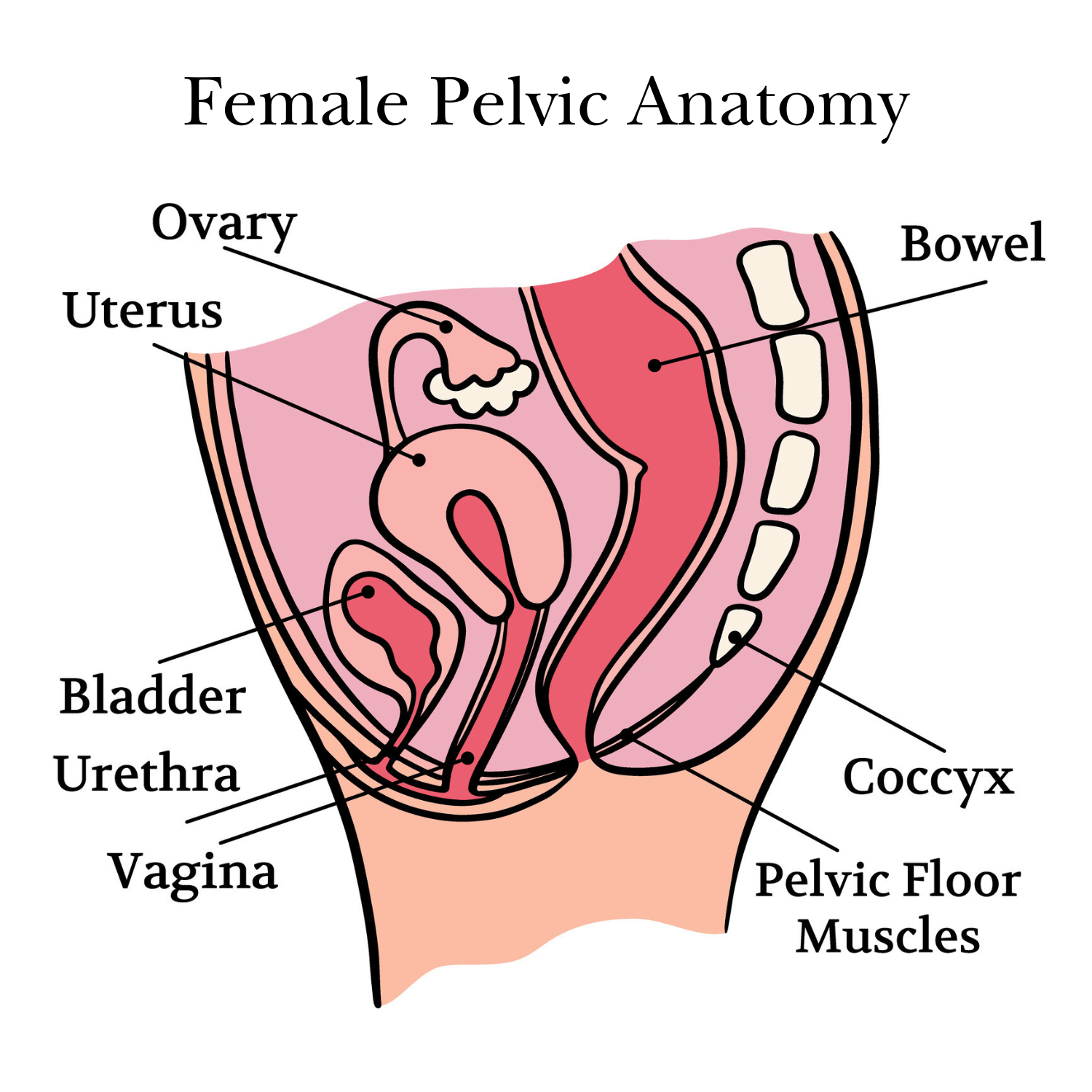
Your pelvic floor muscles are essential
💦 Control of urinary continence
💩 Management of bowel continence
💪 Support to hold pelvic organs
❤️ Enhancement of sexual function
💆♀️ Stabilization of core and lower back
1/3 of women suffer from pelvic floor disorders
These disorders often arise from weakened pelvic floor muscles and can manifest in various symptoms:
Urine leaks
The pelvic floor muscles naturally contract to close the urethra and rectum, and they voluntarily relax during urination and bowel movements.
However, when these muscles weaken, they can no longer maintain a tight seal around the urethra and rectum, resulting in uncontrollable leakage or urgency for both urine and stool.
This problem manifests itself as an involuntary leakage of urine during physical activities such as coughing, sneezing, laughing or exercise (known as stress incontinence), or following an urgent and intense need to urinate (known as urge incontinence).
Urinary urges
Urinary urge is characterized by a sudden, intense need to urinate, sometimes requiring frequent visits to the toilet, even several times during the night. This often results from weakness of the pelvic floor muscles.
Indeed, when these muscles weaken, they can no longer maintain a tight seal around the urethra and rectum, resulting in uncontrollable leakage or urgencies.
Organ prolapse
The most common symptom is a sensation of a vaginal lump or heaviness, primarily felt when standing. This sensation intensifies with physical exertion and tends to lessen when lying down. Over time, this mass may become palpable during bathroom visits and may even become visible, protruding beyond the vulvar or anal opening.
The perineum acts as a hammock for the pelvic organs, supporting them at a sufficient height.
If the perineum weakens, it becomes less firm and sags under the weight of the organs it previously supported. The organs then descend towards one of the pelvic openings.
Diminished sexual well-being
Diminished sexual well-being refers to any physical or psychological issue that prevents sexual satisfaction. In women, weakened pelvic muscles can lead to pain during sexual intercourse, a decrease in desire, or difficulty achieving orgasm.
The perineum plays a crucial role in sexual function by relaxing to open the passage or contracting to increase tension.
Regular pelvic floor exercises can help strengthen these muscles and improve sexual function.
Lower back pain
A weakened pelvic floor can contribute to lower back pain. These muscles play a crucial role in providing core support. When they lose their tone, it can result in an imbalance and heightened tension in the lower back, ultimately leading to discomfort and pain.
What causes pelvic floor weakening?
Pelvic floor muscle weakness and dysfunction are usually associated with one or more of the following risk factors:
Impact sports
Engaging in impact sports like trampolining, basketball, or running places added strain on the pelvic floor muscles, particularly during repetitive jumping and landing motions, potentially causing muscle weakening. Notably, 90% of female trampoline athletes report experiencing stress incontinence.
Heavy lifting
Repeated lifting of heavy objects or participation in activities involving heavy lifting can strain the pelvic floor.
Overweight
Being overweight can put extra pressure on the pelvic floor muscles, leading to their progressive weakening.
Giving birth
Pregnancy and childbirth can put considerable pressure on pelvic floor muscles. Carrying a baby and giving birth can stretch and sometimes damage these muscles.
Hormonal changes
Hormonal fluctuations, such as those that occur during menopause, can contribute to a weakening of the pelvic floor muscles.
Aging
With age, the muscles of the body, including those of the pelvic floor, can naturally weaken and lose some of their tone and elasticity. This is due to reduced physical activity and the physiological changes associated with aging.
Chronic exertion
Conditions leading to chronic effort during bowel movements, such as chronic constipation, can strain pelvic floor muscles.
Medical procedures
Certain medical procedures, such as a hysterectomy (removal of the uterus), can impact the strength of the pelvic floor muscles.

The hidden challenge of pelvic floor strengthening
Strengthening pelvic floor muscles may seem straightforward, but in reality, it can be quite challenging. One of the primary hurdles lies in the struggle to locate and target these muscles. Unlike more visible muscle groups like those in the arms or legs, pelvic floor muscles remain hidden, and their contractions aren't always easily felt or noticed.

Improper exercises can aggravate symptoms
Many individuals are unaware of how to properly strengthen their pelvic floor, leading to inappropriate practices such as improper squats or the "stop pee" technique, which can exacerbate symptoms. Informed practice with feedback is crucial because 40% of women contract the wrong muscles while they believe they are contracting the perineum.

Pelvic floor weakness can be overcome
Contrary to popular belief, weakening of the perineum is not unavoidable. Pelvic floor contraction exercises and the use of innovative technologies, such as biofeedback devices, can effectively strengthen this area. This approach enhances overall health and quality of life, extending far beyond postpartum recovery.
Effectively strengthen pelvic floor muscles with biofeedback
Biofeedback is a modern technology that uses electronic sensors to provide real-time information about muscle activity. In the context of pelvic floor strengthening, biofeedback enables pelvic muscle activity to be visualized and understood.
In a biofeedback device, such as Perifit, force sensors detect contractions and relaxations of the pelvic floor muscles. This data is then transmitted to a mobile app or another device, allowing the user to see in real time the intensity and duration of their muscle contractions. This method not only allows users to monitor whether they are targeting the right muscles, but also helps to tracks progress over time.
Cut-out the guesswork with targeted exercises
One of the main strengths of biofeedback is its ability to eliminate uncertainties in pelvic floor strengthening. Since 40% of women contract the wrong muscles during their initial attempts at perineal rehabilitation, biofeedback offers an undeniable advantage by providing visual and instant confirmation of the correct muscle engagement. This allows for more targeted and effective exercises.
Backed by Research
Biofeedback has been validated by numerous clinical studies, demonstrating its effectiveness in improving pelvic floor health. These studies show that biofeedback users tend to achieve better results in terms of muscle strength, control, and reduction of symptoms related to pelvic floor dysfunctions.
Best alternative to traditional methods
Compared with traditional methods such as unassisted Kegel exercises or Pilates, biofeedback stands out for its precision and interactivity. It offers a more engaging and personalized experience, which can increase motivation and adherence to a regular exercise program.
In summary, biofeedback represents a significant advance in pelvic floor rehabilitation, offering a precise, scientifically validated method tailored to individual needs.
Perifit Care is about as fun as pelvic training can get. For anyone serious about improving their pelvic health in an enjoyable way, Perifit Care is my top recommendation.

Perifit Care exceeded my expectations! I highly recommend Perifit Care if you're looking for help and motivation to strengthen your pelvic floor.

Perifit Care is a lot more fun and interactive than other devices. I will definitely be recommending it to my clients.

Biofeedback with Perifit vs. traditional methods
Comparatively speaking, biofeedback stands out as an effective, evidence-based, and user-centric method. It provides a personalized and precise approach for effectively strengthening the pelvic floor.
Shop Perifit CareBiofeedback with Perifit Care and Care+
Traditional Kegel exercises
Pilates and similar workouts
✅
✅
✅
✅
✅
❌
✅
❌
❌
✅
❌
❌
✅
❌
❌
✅
❌
❌
✅
❌
❌
✅
❌
❌

Perifit can complement your healthcare professional sessions
Perifit is your ideal partner for enhancing your healthcare professional sessions. It provides personalized and effective support for your pelvic floor health at home, making it easier to follow your treatment plan and achieve better results with the guidance of your healthcare provider.






